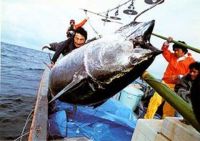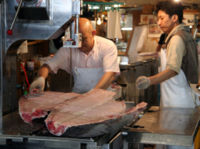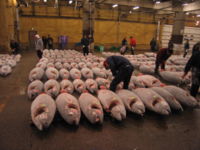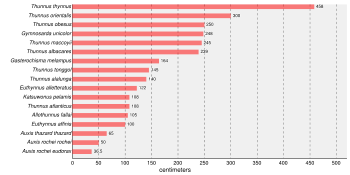Tuna
2008/9 Schools Wikipedia Selection. Related subjects: Insects, Reptiles and Fish
Tuna are several species of ocean-dwelling fish in the family Scombridae, mostly in the genus Thunnus. Tunas are fast swimmers—they have been clocked at 70 km/h (45 mph)—and include several species that are warm-blooded. Unlike most fish species, which have white flesh, tuna have flesh that is pink to dark red. The red coloring comes from tuna muscle tissue's greater quantities of myoglobin, an oxygen-binding molecule. Some of the larger tuna species, such as the bluefin tuna, can raise their blood temperature above that of the water through muscular activity. This ability enables them to live in cooler waters and to survive in a wide range of ocean environments. Tuna species and fisheries have been overfished, and some stocks are at risk of collapse.
Commercial importance
| commercial |
|---|
| fin fish |
| anchovy |
| beluga sturgeon |
| catfish |
| cod |
| atlantic cod |
| eel |
| eel history |
| halibut |
| herring |
| mackerel |
| pollock |
| sillaginids |
| salmon |
| sardine |
| sole |
| sturgeon |
| white sturgeon |
| tilapia |
| toothfish |
| tuna |
| turbot |
| whitebait |
| more... |
|
|
| fishing industry |
| fisheries |
|
|
| I N D E X |
|
|


Tuna is an important commercial fish. Some varieties of tuna, such as the bluefin and bigeye tuna, Thunnus obesus, are threatened by overfishing, which dramatically affects tuna populations in the Atlantic and northwestern Pacific Oceans. Other areas seem to support fairly healthy populations of some of the over 48 different species of tuna —for example, the central and western Pacific skipjack tuna, Katsuwonus pelamis—but there is mounting evidence that overexploitation threatens tuna populations worldwide. The Australian government alleged in 2006 that Japan had illegally overfished southern bluefin by taking 12,000 to 20,000 tonnes per year instead of the their agreed 6,000 tonnes; the value of such overfishing would be as much as USD $2 billion. Such overfishing has resulted in severe damage to stocks. "Japan's huge appetite for tuna will take the most sought-after stocks to the brink of commercial extinction unless fisheries agree on more rigid quotas, wildlife campaigners warned today" stated by the WWF.
Increasing quantities of high-grade tuna are entering the market from operations that rear tuna in net pens and feed them a variety of bait fish. In Australia the southern bluefin tuna, Thunnus maccoyii, is one of two species of bluefin tunas that are kept in tuna farms by former fishermen. Its close relative, the northern bluefin tuna, Thunnus thynnus, is being used to develop tuna farming industries in the Mediterranean, North America and Japan.
Due to their high position in the food chain and the subsequent accumulation of heavy metals from their diet, mercury levels can be high in larger species such as bluefin and albacore. As a result, in March 2004 the United States FDA issued guidelines recommending that pregnant women, nursing mothers and children limit their intake of tuna and other types of predatory fish. However, most canned light tuna is skipjack tuna, which is lower in mercury. The Chicago Tribune reported that some canned light tuna such as yellowfin tuna is significantly higher in mercury than skipjack tuna, and caused Consumers Union and other health groups to advise pregnant women to refrain from consuming canned tuna. The Eastern little tuna ( Euthynnus affinis) has been available for decades as a low-mercury, less expensive canned tuna. However, of the five major species of canned tuna imported by the United States it is the least commercially attractive, primarily due to its dark colour and more pronounced 'fishy' flavor. Its use has traditionally been restricted exclusively to institutional (non-retail) commerce.
Recreational importance
In the 1930s and the 1940s, bluefin tuna were abundant in the waters of Cuba, Bimini and Cat Cay just a few miles off the Florida coast, and were targeted by such fishermen as Ernest Hemingway and Habana Joe aboard his 1938 40-foot Wheeler named Pilar. Word spread quickly among fishermen around the world about the exciting new sport of big-game fishing. Despite the growing popularity of the sport, however, the boats of the day were hardly ideal for the challenges of fighting the prized fish. Most boats used at the time were converted cabin cruisers, which were relatively slow and hard to maneuver.
The Rybovich family of South Florida eventually constructed a boat in 1946 that catapulted the sport and gave birth to a new industry. This boat, the Miss Chevy II, was the first sportfishing boat the world had ever seen.
Merritt gained particular notoriety during the 1950s through the 1970s with its 37- and 43-foot custom sport fishing boats, which together with boats like those being built by Rybovich gave birth to a new category of fishing yachts and helped fuel the growth of big game tuna fishing in the United States and around the world.
Canned tuna
Canned tuna was first produced in 1903, and quickly became popular. In the United States, only Albacore can legally be sold in canned form as "white meat tuna"; in other countries, Yellowfin is also acceptable as "white meat tuna."
While in the early 1980s canned tuna in Australia was most likely to be Southern bluefin, as of 2003 it is usually yellowfin, skipjack, or tongol (labelled "northern bluefin").
As tuna are often caught great distances from where they are processed, poor quality control may lead to spoilage. Tuna are typically eviscerated by hand, then pre-cooked for 45 minutes to three hours. The fish are then cleaned and filleted, packaged into cans, and sealed. The second cooking of the tuna meat (called retort cooking) is carried out in the cans, this time for 2 to 4 hours. This process kills any bacteria, but retains the histamine that can produce rancid flavours. The international standard sets the maximum histamine level at 200 milligrams per kilogram. An Australian study of 53 varieties of unflavored canned tuna found none to exceed the maximum histamine level, although some had "off" flavours.
Australia standards once required cans of tuna to contain at least 51% tuna, but these regulations were dropped in 2003. The remaining weight is usually oil or water. In the US, the FDA has regulations on canned tuna (see part c).
Major tuna fleets
According to the Foodmarket Exchange, the total tuna catch was 3,605,000 tons in 2000, down about 5.7 percent from 3,823,000 tons in 1999. The main tuna fishing nations are concentrated in Asia, with Japan and Taiwan floating the main fleets. Other important tuna fishing nations in Asia are Indonesia and South Korea. Spain and France are also important tuna fishing countries, with their ships fishing primarily in the Indian Ocean.
Japan remains the main tuna fishing nation fishing in the Pacific. In 2000, total tuna caught by Japanese vessels was 633,000 tons, about 17 percent of the world tuna catch. Taiwan was the second biggest tuna producer at 435,000 tons, or about 12 percent of the world's total catch. Spain supplies most of the yellowfin to European canneries, accounting for 5.9 percent of the total tuna catch, while Ecuador and Mexico dominate the Eastern Pacific Ocean.
Tuna fishing and commercial whaling
Some maritime countries such as Nauru have argued that commercial whaling is a necessity for preserving stocks of tuna and the sustainability of that country's fishing fleet.
Management and conservation
There are five main tuna fishery management bodies: the Western Central Pacific Ocean Fisheries Commission, the Inter-American Tropical Tuna Commission, the Indian Ocean Tuna Commission, the International Commission for the Conservation of Atlantic Tunas and the Commission for the Conservation of Southern Bluefin Tuna. The five met together for the first time in Kobe, Japan in January 2007. Environmental organisations made submissions on risks to fisheries and species. The meeting concluded with an action plan drafted by some 60 countries or areas. Concrete steps include issuing certificates of origin to prevent illegal fishing and greater transparency in the setting of regional fishing quotas. The delegates are scheduled to meet at another joint meeting in January or February 2009 in Europe.
Association with dolphins
Many tuna species associate with dolphins, swimming alongside them. These include yellowfin tuna in the eastern Pacific Ocean, but not albacore or skipjack. The reason for the association is believed to be the avoidance of dolphins by sharks, which are predators of tuna. Swimming near dolphins reduces the likelihood of the tuna being attacked by a shark.
Fishing vessels can exploit this association by searching for pods of dolphins. They encircle the pod with nets to catch the tuna beneath. The nets are prone to entangling dolphins, thus injuring or killing them. As a result of public outcry, methods have been made more "dolphin friendly", now generally involving lines rather than nets. However, there are neither universal independent inspection programs nor verification of "dolphin safeness" to show that dolphins are not harmed during tuna fishing. According to Consumers Union, the resulting lack of accountability means claims that tuna is " Dolphin safe" should be given little credence.
Methods of capture
- Andalusian method of Almadraba, in which nets are used, creating a maze in which the tuna are secured.
- big-game fishing
- longline fishing
- purse seines - the major threat to dolphins
- pole and line
- harpoon gun
Species
There are eight tuna species in the Thunnus genus:
- Albacore, Thunnus alalunga ( Bonnaterre, 1788).
- Yellowfin tuna, Thunnus albacares ( Bonnaterre, 1788).
- Blackfin tuna, Thunnus atlanticus ( Lesson, 1831).
- Southern bluefin tuna, Thunnus maccoyii ( Castelnau, 1872).
- Bigeye tuna, Thunnus obesus (Lowe, 1839).
- Pacific bluefin tuna, Thunnus orientalis ( Temminck & Schlegel, 1844).
- Northern bluefin tuna, Thunnus thynnus (Linnaeus, 1758).
- Longtail tuna, Thunnus tonggol ( Bleeker, 1851).
Species of several other genera (all in the family Scombridae) have common names containing "tuna":
- Skipjack tuna Katsuwonus pelamis (Linnaeus, 1758)
- Slender tuna Allothunnus fallai (Serventy, 1948)
- Bullet tuna Auxis rochei (Risso, 1810)
- Frigate tuna Auxis thazard (Lacepede, 1800)
- Kawakawa (little tuna or mackerel tuna) Euthynnus affinis (Cantor, 1849)
- Little tunny (little tuna) Euthynnus alletteratus (Rafinesque, 1810)
- Dogtooth tuna Gymnosarda unicolor ( Rüppell, 1836)
- Black skipjack tuna Euthynnus lineatus (Kishinouye, 1920)
Nutrition and health
Canned tuna is a prominent component in many weight trainers' diets, as it is very high in protein and is easily prepared.
A can of tuna in oil contains about the Adequate Intake (AI) of the US Dietary Reference Intake of vitamin D for infants, children, men, and women aged 19–50 - 200 UI.
Canned tuna can also be a good source of omega-3 fatty acids, of which it sometimes contains over 300 mg per serving.
A January 2008 report conducted by the New York Times has found potentially dangerous levels of mercury in certain varieties of tuna, reporting levels "so high that the Food and Drug Administration could take legal action to remove the fish from the market."



